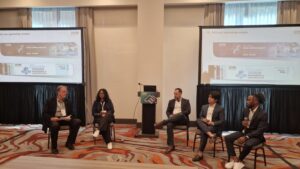UPS in data centers plays a vital role. It ensures an uninterrupted power supply. This prevents catastrophic data loss and operational disruptions. Furthermore, aside from backup power, it can also be used for grid integration and energy conservation. This article examines the use of UPS battery banks for grid services by data centers. It also examines the difficulties and innovations. So, let’s dive in.
The Importance of UPS in Data Centers
Data Centers are high-risk areas. So, even a short outage of electricity can have serious effects. These effects are just too large to ignore. Furthermore, it can range from possible hardware damage to lost data and interrupted operations. UPS brings a dependable buffer between the electrical grid and the data center. So, it makes them excel in such a situation.
Batteries, rectifiers, inverters, and control systems are some of the main parts of a UPS system. The UPS effortlessly transitions to its battery backup if the utility power supply is cut off. As a result, it guarantees that vital loads are powered through until the primary source is restored or a backup generator starts up.
However, UPS in data centers does much more than just provide backup power in data centers. Additionally, these systems are essential for power conditioning. They control variations in frequency and voltage that can cause serious harm to delicate electronic devices. Moreover, UPS systems contribute to the protection of data center operations. It also extends the life of expensive gear by offering a clean, reliable power supply.
Leveraging UPS in Data Centers for Grid Services
Data centers can engage in a variety of grid services through UPS. This can help them earn income and promote the sustainability and stability of the grid. The energy storage capacity of a UPS’s battery banks comes into use here.
Demand Response
Demand response is one of the most promising grid services for data centers equipped with UPS systems. Utilities can request that participating establishments temporarily lower their energy use. This is at times of high electricity demand. Furthermore, data centers can reduce a large amount of their grid-based energy consumption. This is by using their UPS batteries to power essential loads. As a result, this relieves pressure on the utility grid and helps to avoid brownouts or blackouts.
Data centers usually receive payment from the utility in exchange for their participation. It essentially makes their UPS in data centers a source of income. This encourages data centers to adopt more environmentally friendly energy practices. This is while also helping to cover the expenses of running and maintaining these systems.
Frequency Regulation
Frequency control is an additional grid function that data centers can offer via their UPS systems. When frequency stays within a specific range, usually about 60 hertz (Hz) in the US, the electrical grid performs at its best. Meanwhile, frequency variations resulting from supply and demand mismatches can harm equipment. It can also produce instability in the system.
Data centers can contribute to maintaining the appropriate frequency range; This is by quickly charging or draining their UPS batteries in response to grid frequency changes. Given that intermittent sources such as solar and wind can cause frequency variations, this service is especially beneficial. This is when the use of renewable energy is at its highest.
Energy Arbitrage
UPS in data centers are eligible to engage in energy arbitrage in deregulated power markets. To do this, energy must be bought and stored at times of low price. This is usually during off-peak hours and then sold back to the grid during times of high demand and higher pricing.
Data centers are built to consume electricity, not produce it so, it may seem paradoxical to use their UPS battery banks as energy storage assets. However, doing so can be a valuable source of income. This reduces operating expenses and encourages data centers to optimize their energy usage habits. This adds to the sustainability and stability of the grid.
Innovations in UPS Technology for Grid Services For Data Centers
UPS manufacturers are developing cutting-edge technologies. These will be able to improve scalability, energy efficiency, and grid integration capabilities. Let us look at these innovations ahead:
Modular UPS Systems
The fixed capacity of traditional UPS systems makes them monolithic. So, it may not be well suited to the dynamic nature of data center operations. To overcome this difficulty, data centers can expand their power protection capabilities. This is by adding or removing UPS modules as needed. It is made possible by modular UPS systems.
This modular method delivers increased energy efficiency together with increased flexibility and scalability. Moreover, data centers can lower their overall energy usage and minimize energy losses. This is by precisely matching the UPS capacity to the actual load.
Lithium-ion Battery Technology
Lithium-ion batteries are becoming popular quickly. Until now, UPS systems mainly used lead-acid batteries. However, lithium-ion batteries offer many advantages over lead-acid ones. They have a higher energy density, last longer, and charge and discharge faster.
Lithium-ion batteries are especially good for grid services for data centers. They can handle frequent charging and discharging cycles needed for energy trading and demand response. They can also respond faster to changes in power frequency. Additionally, because they last longer, UPS in data centers may cost less over their whole life. This makes them a better choice for data centers in terms of cost-effectiveness.
UPS-as-a-Reserve (UPSaaR)
The UPSaaR idea is among the most fascinating developments in the field of grid services applications. Through direct utility grid integration, UPS systems are converted into distributed energy resources using this method.
Under a UPSaaR scenario, the utility utilizes the battery banks of participating data centers as a virtual power plant. This is to remotely operate and deploy the UPS systems. As the utility manages all dispatching and coordination, this offers a dependable and rapid supply of reserve capacity. It also removes the requirement for data centers to actively engage in grid services.
Although UPSaaR is still a relatively new idea, it has a lot of promise. This is to improve grid resilience and stability and open up new income opportunities for data centers.
UPS In Data Centers: Challenges and Considerations
Although using UPS systems in grid services for data centers offers enticing prospects, data centers also need to handle several issues and concerns.
Battery Lifecycle Management
The longevity of UPS batteries can be greatly impacted by grid service participation. This is because numerous cycles of charging and discharging hasten depreciation. Data centers have to make sure that the money they receive from grid services balances these expenditures. So, it means they have to carefully monitor when and how often they replace batteries.
Cybersecurity and Grid Integration
Cybersecurity issues surface as UPS systems are connected with electricity grids more closely. Strong security measures must be put in place by data centers. It helps to guard their UPS systems against cyberattacks that can jeopardize their daily operations. It can also help the stability of the larger grid.
Regulatory and Market Considerations
Regulations and market mechanisms have a significant impact on data centers’ capacity to engage in grid services. Legal restrictions can prevent adoption in certain areas. However, deregulated power markets and supportive policies encourage involvement in others.
Furthermore, data centers need to stay up to date with changing laws and market conditions. It helps to take advantage of grid service possibilities and maintain compliance.
To Sum Up
Data centers can maintain continuous operations, support grid stability, create money, and embrace a more sustainable energy future by utilizing the grid services capabilities of their UPS systems.
UPS in data centers provides a plethora of chances for grid connection. However, to fully capitalize on these opportunities, creativity, foresight, and a dedication to sustainability are necessary. Attending the upcoming Energy Efficiency for Data Centers Summit on May 16-17, 2024, in Dallas TX, USA. With this, you can explore the latest advancements, best practices, and strategies. This is for leveraging UPS systems to drive energy efficiency and grid services in the data center industry. Register now!



